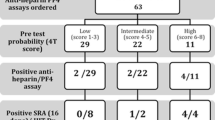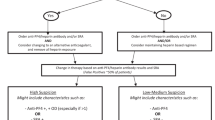Abstract
Patients on mechanical circulatory support (MCS) devices carry a high risk for thrombocytopenia and due to the routine use of heparin, heparin induced thrombocytopenia (HIT) is frequently suspected. HIT Expert Panel (HEP) and 4T scoring tools have been validated in the general medicine population to assess the probability of HIT diagnosis, however, these tests have not been validated for use in patients requiring MCS support. The objective of this study was to assess the association of 4T and HEP scores to available assess HIT diagnostic tests in patients requiring MCS. We conducted a retrospective review of patients requiring MCS who had heparin PF4 antibody optical density and/or serotonin release assay results reported. A 4T and HEP score at the time of heparin antibody ordering was calculated. Utilizing previously described ranges for HIT diagnostic tests, patients were categorized into two HIT probability categories: probable and not probable. Descriptive statistics were used for the 4T and HEP scores in both HIT probability categories and t-test and receiver operating characteristic (ROC) analysis were used to determine the association and agreement between each scoring tool and HIT probability. Eighty-five patients were identified who had HIT diagnostic tests ordered while on MCS; 7 patients were classified as HIT probable and 78 patients were classified as HIT not probable. Based on ROC analysis, 4T score and HEP score had an AUC of 0.88 (± 0.06) and 0.96 (± 0.02), respectively demonstrating high predictability of HIT. Utilizing sensitivity and specificity analysis through ROC curves, a cut off score of 3 for 4T score and 1 for HEP score was established. Based on our analysis, both 4T and HEP scores have high predictability of HIT in the mechanical circulatory support population.





Similar content being viewed by others
References
Bream-Rouwenhorst HR, Hobbs RA, Horwitz PA (2008) Thrombocytopenia in patients treated with heparin, combination antiplatelet therapy, and intra-aortic balloon pump counterpulsation. J Interv Cardiol 21:350–356
Roy SK, Howard EW, Panza JA, Cooper HA (2010) Clinical implications of thrombocytopenia among patients undergoing intra-aortic balloon pump counterpulsation in the coronary care unit. Clin Cardiol 33:30–35
Vonderheide RH, Thadhani R, Kuter DJ (1998) Association of thrombocytopenia with the use of intra-aortic balloon pumps. Am J Med 105:27–32
Bain J, Flannery AH, Flynn J, Dager W (2017) Heparin induced thrombocytopenia with mechanical circulatory support devices: review of the literature and management considerations. J Thromb Thrombolysis 44:76–87
Amiral J, Bridley F, Dreyfus M, Vissoc AM, Fressinaud E, Wolf M, Meyer D (1992) Platelet factor 4 complexed to heparin is the target for antibodies generated in heparin-induced thrombocytopenia. Thromb Haemost 68:95–96
Nazi I, Arnold DM, Warkentin TE, Smith JW, Kelton JG (2015) Distinguishing between anti-platelet factor 4/heparin antibodies that can and cannot cause heparin-induced thrombocytopenia. J Thromb Haemost 13:1900–1907
Warkentin TE, Greinacher A (2013) Laboratory testing for heparin-induced thrombocytopenia. In: Warkentin TE, Greinacher A (eds) Heparin-induced thrombocytopenia, 5th edn. Informa Healthcare, New York, pp 272–314
Warkentin TE, Arnold DM, Nazi I, Kelton JG (2015) The platelet serotonin-release assay. Am J Hematol 90:564–572
Lo GK, Juhl D, Warkentin TE, Sigouin CS, Eichler P, Greinacher A (2006) Evaluation of pretest clinical score (4 T’s) for the diagnosis of heparin-induced thrombocytopenia in two clinical settings. J Thromb Haemost 4:759–765
Cuker A, Gimotty PA, Crowther MA, Warkentin TE (2012) Predictive value of the 4Ts scoring system for heparin-induced thrombocytopenia: a systematic review and meta-analysis. Blood 120:4160–4167
Cuker A, Arepally G, Crowther MA, Rice L, Datko F, Hook K, Propert KJ, Kuter DJ, Ortel TL, Konkle BA, Cines DB (2010) The HIT Expert Probability (HEP) Score: a novel pre-test probability model for heparin-induced thrombocytopenia based on broad expert opinion. J Thromb Haemost 8:2642–2650
DeLong ER, DeLong DM, Clarke-Pearson DL (1988) Comparing the areas under two or more correlated receiver operating characteristic curves: a nonparametric approach. Biometrics 44:837–845
Funding
No funding was received to conduct any portion of this study.
Author information
Authors and Affiliations
Contributions
TMT assisted in the design of the study, performed data collection, assisted in data analysis and interpretation and drafted the manuscript. AF conceived the presented study design, assisted in the data interpretation, performed critical revision of the article and provided the final approval of the version to be published. QX performed data analysis, performed data interpretation and created the associated figures and tables. KD assisted in the design of the study, assisted in data interpretation, performed critical revision of the article and provided the final approval of the version to be published.
Corresponding author
Ethics declarations
Conflict of interest
All authors do not have any financial or non-financial conflicts of interest to disclose.
Informed consent
Finally, due to the retrospective nature of this study, informed consent was not needed to conduct this study. This study was reviewed and approved by our institution’s Institutional Review Board.
Additional information
Publisher’s Note
Springer Nature remains neutral with regard to jurisdictional claims in published maps and institutional affiliations.
Rights and permissions
About this article
Cite this article
Thomas, T., Fuentes, A., Xu, Q. et al. Evaluation of heparin induced thrombocytopenia using probability scores in a mechanical circulatory support population. J Thromb Thrombolysis 48, 134–140 (2019). https://doi.org/10.1007/s11239-019-01843-8
Published:
Issue Date:
DOI: https://doi.org/10.1007/s11239-019-01843-8




